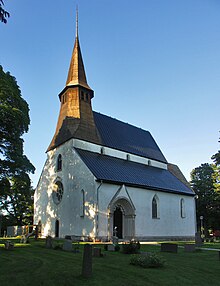
Bro Church is a medieval era Lutheran church at Bro on the Swedish island Gotland. Situated on what was possibly a pre-Christian sacred site, the presently visible church was built during the 13th century. Stylistically, its architecture shows a mix of Romanesque and Gothic elements. It still contains some medieval furnishings, including a baptismal font by Sigraf, and murals. The church belongs to the Väskinde parish in the Diocese of Visby of the Church of Sweden.
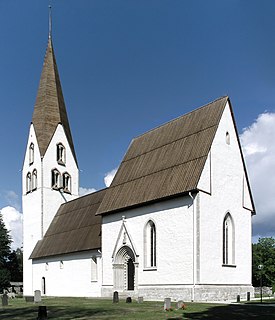
Garde Church is a medieval church in Garde on the Swedish island of Gotland. It was built in stages during the Middle Ages. The oldest part is the nave and the base of the tower, while the most recently constructed part is the large chancel. A large renovation was carried out in the 1960s. Garde Church together with its cemetery and its four lychgates constitute one of the most well-preserved medieval church ensembles in Sweden.

Fröjel Church is a medieval church in Fröjel on the Swedish island of Gotland. Fröjel Church may have been built to serve not only as a church, but also as a fortification. Stylistically, it is a mix of Romanesque and Gothic architecture, and contains murals from the early 14th century. It is associated with the Diocese of Visby of the Church of Sweden.
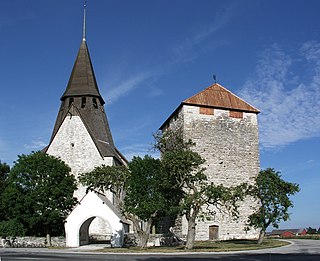
Gammelgarn Church is a medieval church in Gammelgarn on the Swedish island of Gotland. The largely Gothic church stands next to an older defensive tower. The church's main portal is richly decorated with medieval sculpture, and the interior contains an altarpiece from the 14th century of high craftsmanship. The church is in the Diocese of Visby of the Church of Sweden.

Lau Church is a medieval church on the Swedish island of Gotland, in the Diocese of Visby. It is an unusually large church, and may have been used by Dominicans preaching for the Crusades.
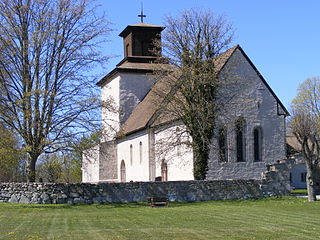
Vamlingbo Church is a medieval church on the Swedish island of Gotland, and one of the largest on the island. It lies in the Diocese of Visby.
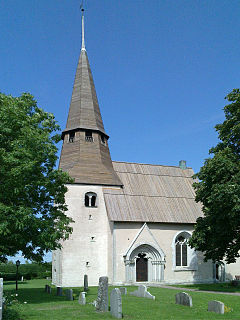
Ardre Church is a medieval church in Ardre on the Swedish island of Gotland. It was built during the 13th century, but the interior re-decorated in 1900–1902 after plans by artist Axel Haig. Several of the furnishings of the church are medieval. The church is in the Diocese of Visby of the Church of Sweden.

Barlingbo Church is a medieval church in Barlingbo on the Swedish island of Gotland. It dates from the 13th century and has been altered little since. It contains furnishings from several centuries, including an unusual medieval baptismal font, decorated with figures and runes. The church belongs to the Church of Sweden and lies in the Diocese of Visby.

Buttle Church is a medieval church in Buttle on the Swedish island of Gotland. It is one of the more well-preserved Romanesque churches on Gotland, and contains both a number of medieval furnishings as well medieval murals. Buttle Church belongs to the Diocese of Visby of the Church of Sweden.

Bäl Church is a medieval church in Gute, Bäl, on the Swedish island of Gotland. It was built during the first half of the 13th century and contains sculptural decoration in both Romanesque and Gothic styles. The interior is decorated by medieval wall paintings. It belongs to the parish Väskinde, in the Diocese of Visby.

Dalhem Church is a medieval church in Dalhem on the Swedish island of Gotland. Built in the 13th and 14th century, the church underwent major changes during a renovation at the turn of the 19th–20th centuries. Dalhem Church lies in the Diocese of Visby of the Church of Sweden.

Endre Church is a medieval church in Endre on the Swedish island of Gotland, in the Diocese of Visby, built from the 12th to early 14th century. It contains medieval murals and several medieval furnishings, and belongs to the Church of Sweden.

Hangvar Church is a medieval church in Hangvar on the Swedish island of Gotland. It is part of the Diocese of Visby.
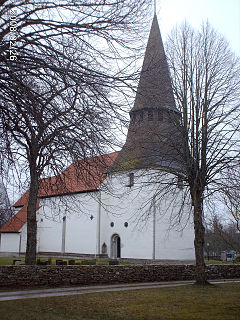
Hogrän Church is a medieval church in Hogrän on the Swedish island of Gotland. It was built in stages between the 12th and 14th century, and contains several medieval church fittings. It belongs to the Church of Sweden and lies in the Diocese of Visby.

Hejde Church is a medieval Lutheran church in Hejde on the island of Gotland It lies the Diocese of Visby.

Vall Church is a medieval church on the Swedish island of Gotland. The largely Romanesque church dates from the 13th century. It belongs to the Diocese of Visby.

Silte Church is an almost unaltered medieval church on the Swedish island of Gotland. Silte Church was built during the 13th century and contains a number of medieval fittings as well as murals. It belongs to the Church of Sweden and lies in the Diocese of Visby.
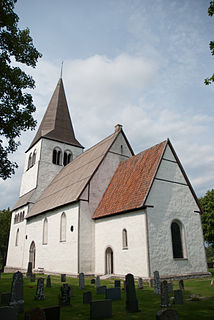
Rute Church is a medieval church in Rute on the Swedish island Gotland, in the Baltic Sea. The 13th century church contains medieval murals, and is unusual in that its vaults are supported by square pillars and not round columns. It belongs to the Diocese of Visby.

Vallstena Church is a medieval church on the island of Gotland, Sweden. It belongs to the Diocese of Visby.
